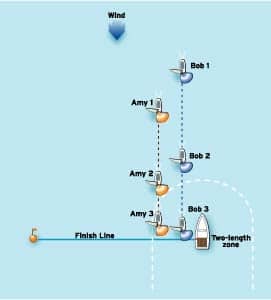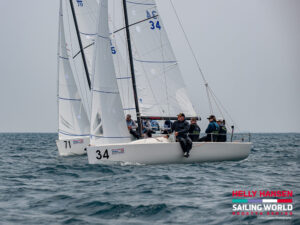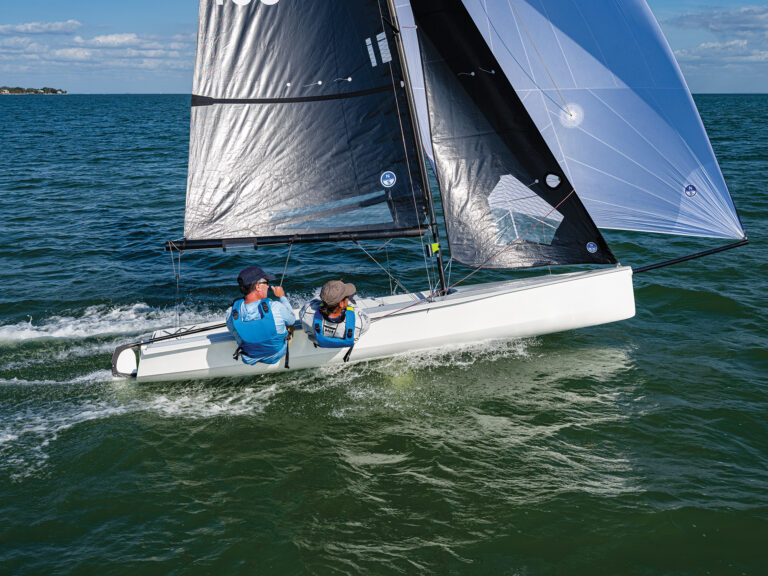
Tricky Questions About Informal Racing
Lots of the races in North America are informal “beer can” evening races open to all comers. The sailing instructions and committee procedures are often simple, direct, and designed to work with whatever volunteers and limited facilities are available. Two readers have written to me posing interesting rules puzzles that cropped up in such races.
Chuck Sherfey asked several questions about an incident that occurred during a Wednesday night PHRF series in the Chicago area. First, lets go over the facts. Each Wednesday, one competitor volunteered to skip the race and donate his boat as the race committee boat. One of the sailing instructions stated, “A boat may protest another boat for an alleged breach of a rule in Part 2 only if there was physical contact that caused damage. (This changes Rule 60.1(a)).” The incident took place at the committee boat end of the finish line between two boats running on port tack (see diagram). Amy was clear ahead of Bob, who was overhauling her. When the boats reached the two-length zone around the committee boat there was doubt as to whether or not Bob had managed to obtain an overlap. He hailed “Room,” and Amy replied “No overlap. No room.” By the time the boats were alongside the committee boat there definitely was an overlap. Bob did not have enough room to avoid both Amy and the committee boat. He did not hit Amy, but his spinnaker pole twanged the committee boats shroud. Bob hailed “Protest” and flew his protest flag.
Because of the unusual sailing instruction, Bob knew that his protest would not be valid unless there was some damage. His boat was undamaged, but he did not know whether the committee boat had been damaged. After the race, he asked Mike, the owner of the committee boat, if his shroud had been damaged. Mike replied that he did not know, but that he would have his boatyard check out the rigging. The inspection did not occur until several weeks later, and it showed that Mikes shroud was indeed damaged.
Question: According to Rule 61.3, protests should have been delivered to the protest committee no later than two hours after the last boat in the race finished. That time limit must be extended if there is “good reason” to do so. Can the extension of time be as long as several weeks?
Answer: If the protest committee thinks that there was a good reason for the long delay, it may extend the time limit, even for several weeks.
Q: When Bob heard that the committee boat had been damaged, he decided not to protest, but Mike decided to protest Bob. He pointed out that his boat had entered the series and that Rule 60.1(a) allowed him to protest “another boat.” Is such a protest permitted?
A: The word “boat” is used in the rules to refer to boats that are actually competing in a race. In particular, the preamble to Part 2 of the rules states that the rules apply “between boats that¿intend to race¿” In my opinion, Mike is not permitted to protest under Rule 60.1(a). However, the race committee may protest under Rule 60.2(a). If Mike was not actually a member of the race committee, then to bring the incident to a hearing Mike must convince the race committee to protest.
Q: Suppose Mike convinced the race committee to protest. Should it protest under Rule 14 (Avoiding Contact), Rule 31 (Touching a Mark), or Rule 18.2 (Giving Room; Keeping Clear)?
A: It doesn’t matter. The sailing instruction quoted above applied only to protests between boats, and not to a protest by the race committee against a boat. At the beginning of the hearing, the protest committee must decide whether the protest is valid (see Rule 63.5). The protest will be valid if it identifies the incident and if the protest committee is convinced that there is “good reason” for extending the protest time limit. Once the protest committee decides that a protest is valid, it must decide it and, according to Rule 64.1(a), disqualify any boat that has broken a rule “whether or not the applicable rule was mentioned in the protest.”
Rule 14 was not broken in this incident because it applies to contact between boats and not to contact between a boat and a mark. The decision will turn on one crucial fact–whether Bob had an overlap when Amy reached the two-length zone. If the committee decides as a fact that there was an overlap when Amy reached the zone and that Amy did not give Bob enough room to avoid the committee boat, then it should disqualify Amy under Rule 18.2(a) and exonerate Bob for touching the mark. If it finds that there was no overlap when Amy reached the zone, then it should disqualify Bob for breaking Rule 31.1. If the committee finds that there was a “reasonable doubt” that Bob obtained an overlap in time, then it must, according to Rule 18.2(e), presume that he did not obtain the overlap in time and, accordingly, disqualify him under Rule 31.1.
Q: Mike would like to have either Bob or Amy pay for the repair of his shroud. May the protest committee direct the boat at fault to pay?
A: No. The protest committee’s role is to apply the rules so that the race may be fairly scored. It has neither the responsibility nor the authority to require any boat to pay the cost of repairing damage to any other boat. The US SAILING prescription to Rule 68, Damages, states, “No protest committee’shall adjudicate any claim for damages.” Here the word “damages” refers not to physical damage but to the costs incurred as a result of physical damage or injury. A claim for damages must be resolved by the owners involved, their insurance companies and, in rare instances, the courts. The findings of a protest committee are often cited during negotiations involving damages. The prescription says that a boat that breaks a rule and, in so doing, physically damages another boat is responsible for paying the costs of repair, but it clearly states that the protest committee is not to be involved in such negotiations.
Another reader, Keith Isakson, has written me with a question about a pursuit race. A pursuit race is a race for a handicapped fleet in which each boat is assigned a different starting time with slower boats starting first and faster ones later. The race is sailed boat-on-boat, without correcting finish times. The boat that crosses the finish line first is the winner, the next is second, etc. If the handicaps work perfectly and everyone sails equally well, then in theory all the boats should finish at the same instant. I have sailed a number of pursuit races and found them to be great fun.
Care must be taken in writing the sailing instructions for the start of a pursuit race. Obviously, a sailing instruction must replace Rule 26, Starting Races. In Keiths case, that sailing instruction did not specify a preparatory signal. This can create serious problems, as Keith discovered. Keith was on port tack when a starboard-tack boat changed course and came toward him. He tried to avoid the other boat but failed. The collision occurred four minutes before Keiths starting time and seven minutes before the starboard-tack boats starting time.
Q: Keith asks, “Were the boats racing at the time of the incident?”
A: Obviously, both were involved in a race at that time. However, before her preparatory signal a boat is not racing in the defined sense in which that word is used in the rules. If the sailing instruction changing Rule 26 fails to specify a preparatory signal, then it is impossible to determine at a given moment prior to a boat’s starting time whether or not she is racing. Because the collision occurred in the racing area the racing rules applied, even if one or both of the boats was not racing (see the preamble to Part 2).
E-mail for Dick Rose may be sent to [email protected].









